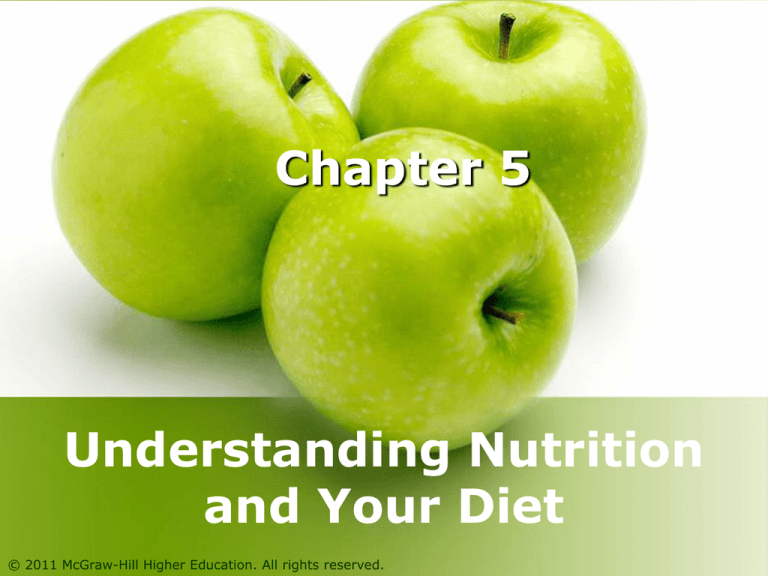
Chapter 5
Understanding Nutrition
and Your Diet
© 2011 McGraw-Hill Higher Education. All rights reserved.
Nutrients
•
Nutrients = elements in food that are
required for the growth, repair, and
regulation of body processes
1. Carbohydrates
2. Fats
3. Protein
4. Vitamins
5. Minerals
6. Water
7. Fiber
© 2011 McGraw-Hill Higher Education. All rights reserved.
Energy from Food
Calorie = unit of energy
1 calorie = amount of energy needed
to raise the temperature of 1 gram of
water by 1 degree Celsius
In common usage, “calorie” refers to
“kilocalorie” (1,000 calories)
© 2011 McGraw-Hill Higher Education. All rights reserved.
Carbohydrates
Major energy source: 4 calories/gram
Types
Monosaccharides
Disaccharides
Polysaccharides
Recommended intake: 45-65% of
total calories from carbohydrates
© 2011 McGraw-Hill Higher Education. All rights reserved.
Carbohydrates
Simple sugars
Average American adult consumes about
156 pounds of sweeteners each year
Sugar, corn sweetener, syrup, honey
Sodas, candy, bakery and processed goods
Sugar substitutes
Saccharin
Aspartame
Sucralose, tagatose
Sorbitol, xylitol
Acesulfame potassium
Neotame
Stevia
© 2011 McGraw-Hill Higher Education. All rights reserved.
Fats
Functions: Insulation, carrier of
vitamins, storage of long-term energy,
and satiety
Energy source: 9 calories/gram
Types
Saturated
Monounsaturated
Polyunsaturated
Trans
Recommended intake: 20-35% of
total calories
© 2011 McGraw-Hill Higher Education. All rights reserved.
Types of Fats
Saturated fats
Solid at room temperature
Primarily found in animal fats
Negative effects on heart health
Monounsaturated and polyunsaturated fats
Liquid at room temperature
Vegetable oils
Positive effects on heart health
Omega-3 polyunsaturated fats found in fish are
considered especially healthful
© 2011 McGraw-Hill Higher Education. All rights reserved.
Composition of Dietary Fats
© 2011 McGraw-Hill Higher Education. All rights reserved.
Types of Fats: Trans Fats
Altered form of unsaturated fat
(hydrogen added)
Associated with unhealthy changes in
cell membranes
Raises levels of “bad” cholesterol and
lowers levels of “good” cholesterol
Found in margarine, snack foods, and
some deep fried fast foods
Check food labels
© 2011 McGraw-Hill Higher Education. All rights reserved.
Types of Fats: Cholesterol
White fatlike substance found in
cells of animal origin
Functions: Synthesizes cell
membranes; starting material in
formation of hormones and bile
The liver can synthesize cholesterol
Excess cholesterol in the body can
clog arteries and increase risk of
cardiovascular disease
© 2011 McGraw-Hill Higher Education. All rights reserved.
Fats
Low-fat foods
Fat substitutes
Low-fat does not
necessarily mean
low-calorie
Higher price tag
Low-fat dairy and
salad dressings have
less saturated fat
Simplesse, Olestra
Fats cannot be
broken down and
absorbed by body
Unpleasant side
effects
© 2011 McGraw-Hill Higher Education. All rights reserved.
Fats: General
Recommendations
20-35% of total daily calories from fat
Less than 10% of calories from
saturated fat
Less than 300 mg/day of cholesterol
Keep trans-fatty acid consumption as
low as possible
Get most fats from sources of
unsaturated fats
Fish
Nuts
Vegetable oils
© 2011 McGraw-Hill Higher Education. All rights reserved.
Protein
Functions: Growth and maintenance
of tissue, acid-base balance
Energy source: 4 calories/gram
Amino acids = building blocks of
protein
11 can be built by the body
Nonessential
amino acids
9 must be obtained from food
Essential
amino acids
© 2011 McGraw-Hill Higher Education. All rights reserved.
Protein
Complete protein sources supply all
essential amino acids
Incomplete protein sources supply
some but not all essential amino acids
Animal foods, soybeans
Plant foods
Recommended intake: 10-35% of
total calories
© 2011 McGraw-Hill Higher Education. All rights reserved.
Vitamins
Organic compounds needed in small
amounts for normal growth,
reproduction, and maintenance of health
Serve as co-enzymes
Provide no energy: 0 calories/gram
Types
Water soluble
B-complex vitamins and vitamin C
Fat soluble
Vitamins A, D, E, K
© 2011 McGraw-Hill Higher Education. All rights reserved.
Vitamins: Should I Take a
Supplement?
Following dietary recommendations would
allow most Americans to meet their
nutrient needs without supplements
Caution with using supplements
Many people eat too many nutrient-deficient
foods
Hypervitaminosis = toxicity
Megadoses of any vitamin can be harmful
Recommendations for certain groups
Folic acid, vitamin B-12, vitamin D
© 2011 McGraw-Hill Higher Education. All rights reserved.
Phytochemicals
Phytochemicals = physiologically active
components of foods that may
deactivate carcinogens
Many phytochemicals function as
antioxidants
May protect cells from damage caused by
unstable molecules (“free radicals”)
Examples
Carotenoids
Polyphenols
Allyl sulfides
© 2011 McGraw-Hill Higher Education. All rights reserved.
Minerals
Inorganic materials that act as
structural elements and regulators of
numerous body processes
Provide no energy: 0 calories/gram
Types
Macronutrients: “Major minerals” found in
high amounts in the body
Micronutrients: “Trace elements” found in
small amounts in the body
© 2011 McGraw-Hill Higher Education. All rights reserved.
Water and Fluids
Average adult loses about 10 cups of water
per day
Urination, bowel movements, breathing,
perspiration
Functions: Provide medium for nutrients,
waste transport, temperature control
For every pound of body weight, you need
about 0.5 ounce of fluid
Sources: Beverages, fruits, vegetables
© 2011 McGraw-Hill Higher Education. All rights reserved.
Fiber
Cellulose-based plant material that
cannot be digested
Provides no energy: 0 calories/gram
Types:
Benefits
Soluble (gel-forming)
Insoluble (absorbs water)
Moves stool through digestive tract
Lowers blood cholesterol levels
Steadies blood sugar levels
Recommended: 21-38 grams/day
Most American adults: 11 grams/day
© 2011 McGraw-Hill Higher Education. All rights reserved.
The Digestive System: The
Absorption of Nutrients
© 2011 McGraw-Hill Higher Education. All rights reserved.
Tools for Planning a
Healthy Diet
The USDA Food Guide:
MyPyramid
The Dietary Guidelines for
Americans
© 2011 McGraw-Hill Higher Education. All rights reserved.
MyPyramid
© 2011 McGraw-Hill Higher Education. All rights reserved.
© 2011 McGraw-Hill Higher Education. All rights reserved.
MyPyramid
Personalized approach
Amounts recommended from each food
group vary based on age, gender, and
activity level
Visit www.mypyramid.gov
Balance food intake and physical
activity
© 2011 McGraw-Hill Higher Education. All rights reserved.
MyPyramid Food Groups
Fruits
2 cups/day for a 2,000-calorie diet
Eat a variety of fruits
Favor whole fruits over fruit juices
Vegetables
2 1/2 cups/day for a 2,000-calorie diet
Eat a variety of vegetables
Dark green vegetables
Orange vegetables
Legumes
Starchy vegetables
Other vegetables
© 2011 McGraw-Hill Higher Education. All rights reserved.
MyPyramid Food Groups
Milk and milk products
3 cups/day for a 2,000-calorie diet
Favor fat-free or low-fat products
Vegans and those who are lactose
intolerant should choose other sources of
calcium
© 2011 McGraw-Hill Higher Education. All rights reserved.
MyPyramid Food Groups
Meat, poultry, fish, eggs, dry
beans, and nuts
5 1/2 ounce-equivalents for a 2,000calorie diet
1 ounce equivalents:
1
ounce cooked meat, poultry, fish
1 egg
1/4 cup legumes or tofu
1 tablespoon peanut butter
1/2 ounce nuts or seeds
Choose lean and low-fat foods
© 2011 McGraw-Hill Higher Education. All rights reserved.
MyPyramid Food Groups
Breads, cereals, rice, and pasta
6 ounces/day for a 2,000-calorie diet
3 or more ounces/day should be whole
grains
1 ounce equivalents:
1
slice bread
1 cup dry cereal
1/2 cup cooked rice, pasta, cereal
© 2011 McGraw-Hill Higher Education. All rights reserved.
MyPyramid Food Groups
Oils (vegetable oils, fish, nuts, seeds)
24 grams or 6 teaspoons/day for a
2,000-calorie diet
1 teaspoon equivalents:
1
teaspoon vegetable oil or margarine
1 tablespoon low-fat mayonnaise
2 tablespoons light salad dressing
Discretionary calories
© 2011 McGraw-Hill Higher Education. All rights reserved.
Dietary Guidelines for
Americans
Focus on Nutrient Density
Consume nutrient-dense foods within
and among the food groups
Weight management
Balance calories from foods and
beverages with calories expended
Make small decreases in calorie intake to
prevent gradual weight gain over time
© 2011 McGraw-Hill Higher Education. All rights reserved.
Dietary Guidelines for
Americans
Physical activity
Regular moderate physical activity
30
minutes/day to reduce risk of chronic
disease
60 minutes/day to prevent gradual,
unhealthy weight gain
60-90 minutes/day to sustain weight loss
Decrease sedentary activities
© 2011 McGraw-Hill Higher Education. All rights reserved.
Dietary Guidelines for
Americans
Food groups to encourage
Fruits
Vegetables
Milk
© 2011 McGraw-Hill Higher Education. All rights reserved.
Dietary Guidelines for
Americans
Foods to Limit
Fats, Sugars, Sodium, and Alcohol
Fats
Most fat calories should come from
polyunsaturated and monounsaturated
fats
© 2011 McGraw-Hill Higher Education. All rights reserved.
Dietary Guidelines for
Americans
Sugar consumption
Choose and prepare foods with little added
sugar
Sodium Intake
Sodium: Consume less than 2,300 mg/day
(about 1 teaspoon of salt)
Too much sodium is linked to hypertension
© 2011 McGraw-Hill Higher Education. All rights reserved.
Dietary Guidelines for
Americans
Alcoholic beverages
Those who choose to drink should do so
sensibly and in moderation
Up
to 1 drink/day for women
Up to 2 drinks/day for men
Food safety
Take steps to avoid microbial foodborne
illness
© 2011 McGraw-Hill Higher Education. All rights reserved.
Vegetarian Diets
Reliance on plant sources for most of the
nutrients the body needs
Ovovegetarian: Includes eggs
Lactovegetarian: Includes dairy
Ovolactovegetarian: Includes eggs and dairy
Vegan: Excludes all animal products
Requires more planning
Need to maintain adequate intake of vitamin B-12,
calcium, iron, zinc, vitamin D
Semivegetarian: Great reduction (but not
elimination) of meat products
Pescovegetarian: Includes fish, eggs, dairy products
© 2011 McGraw-Hill Higher Education. All rights reserved.
Nutrition and the Older Adult
Older adults may find food less
tasteful, harder to chew
Lower energy requirements
Psychosocial factors
Social isolation
Depression
Alcohol consumption
Limited transportation
© 2011 McGraw-Hill Higher Education. All rights reserved.
Food Labels
Required by the FDA
since 1973
New in 2006
Amount of trans fat
Proteins derived from
major food allergen
sources
© 2011 McGraw-Hill Higher Education. All rights reserved.
Nutrition
Facts Label
© 2011 McGraw-Hill Higher Education. All rights reserved.
Fast Foods
Fat density of fast foods
40-70% of calories in fast foods is fat
Recommended intake: 20-35% of total
daily calories from fat
Most people underestimate the calorie
content in a fast food meal
© 2011 McGraw-Hill Higher Education. All rights reserved.
Functional Foods
Foods capable of contributing to the
improvement or prevention of specific
health problems
Probiotics: Living bacteria that help
prevent disease and strengthen the
immune system (e.g., yogurt)
Garlic, olive oil, high-fiber foods, calciumrich foods, antioxident-rich foods
Foods enriched with folic acid
© 2011 McGraw-Hill Higher Education. All rights reserved.
Dietary Supplements
Products that supplement the total daily
intake of nutrients in the diet
Ingested in tablet, capsule, softgel, gelcap,
and liquid form
Not in themselves used as conventional
foods or as the only items in a meal or diet
Must be deemed safe for human use
Cannot claim to cure or prevent illnesses
Exceptions:
Folic acid, calcium
© 2011 McGraw-Hill Higher Education. All rights reserved.
Food Allergies
Allergy = reaction in which the immune
system attacks an otherwise harmless
food or ingredient
Different from a food intolerance, which is
usually caused by an enzyme deficiency
Common food allergens include peanuts,
milk, soy products, shellfish, and wheat
Allergic reactions can develop slowly over
several exposures
Symptoms range from mildly unpleasant to
life threatening
© 2011 McGraw-Hill Higher Education. All rights reserved.
Food Safety
Preventing
foodborne
illness
Safe handling,
cooking, and
storage of
foods
© 2011 McGraw-Hill Higher Education. All rights reserved.
Food Safety
Food irradiation
Use of radiation to kill foodborne
pathogens
Safe farming techniques
More humane treatment of farm animals
Improved food quality
Reduced exposure to antibiotic-resistant
bacteria, prions (cause of “mad cow
disease”), and chemicals
© 2011 McGraw-Hill Higher Education. All rights reserved.
Food Safety
Organic foods
No use of growth
hormone or antibiotics
Not genetically
engineered or irradiated
No use of chemical
fertilizers or sewage
sludge
Diseases, pets, and
weeds treated or
controlled primarily with
nonchemical means
© 2011 McGraw-Hill Higher Education. All rights reserved.
Food Safety
Food additives
Provide color or flavor
Improve nutritional content, texture,
or shelf life
FDA tested
Questionable additives: aspartame,
stevia, and some food colorings
Genetically modified foods
Altered to improve yields and reduce
costs
© 2011 McGraw-Hill Higher Education. All rights reserved.
Chapter Five:
Understanding Nutrition and Your Diet
© 2011 McGraw-Hill Higher Education. All rights reserved.





